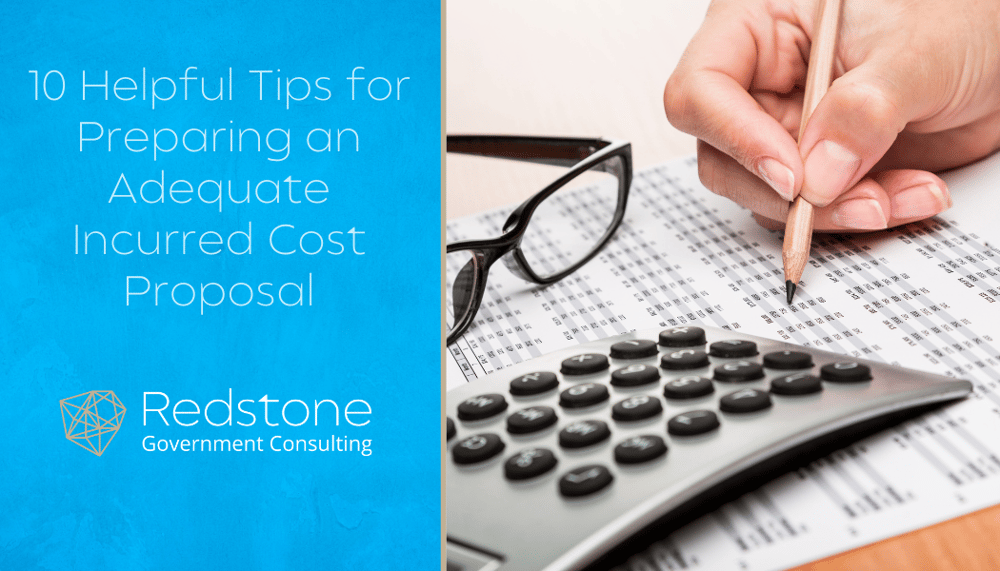
Most contractors (those with calendar year ends) have incurred cost proposals (ICP) due to the government on June 30 and we know that preparing the incurred cost proposal can be stressful and time consuming. We have prepared 10 helpful tips for contractors to consider when preparing their ICP this year to help alleviate stress, reduce the amount of time spent preparing the ICP and most importantly to result in ICP adequacy.
1. Start Early
Don't wait until the week before your ICP is due to begin the preparation of the multiple schedules required to constitute an adequate incurred cost proposal. Waiting till the last minute leads to mistakes and mistakes could lead to submissions being considered inadequate or cost being misrepresented. Start now preparing your submission and give yourself time to adequately review your submission before you submit it on June 30.
2. Understand Which Contracts Require an ICP and Which are Exempt
For the most part, contracts that have cost reimbursable features (cost plus, T&M) require an ICP. However the true driver of determining which contracts require the submission of an ICP is a FAR Clause. FAR 52.216-7 is the Allowable Cost and Payment Clause and this is the clause that when inserted into a contract requires a contractor to submit an incurred cost proposal.
3. Ensure All Costs are Represented
Perform a reconciliation of your trial balance expense accounts to your ICP. You don't want to leave valid, allowable cost out of your submission. A good place to start is with the total cost on Schedule H then reconcile that number to the summation of the total cost reflected in the trial balance. If any and all variances cannot be explained, then there is something wrong and it’s time to review the individual schedules of the ICP to determine where the error or errors lie.
4. Schedule H Cost Should be Reflected at the Billing Level
The billing level (the level of detail and summation required to bill cost) varies from contract to contract. Some contracts are billed at the CLIN level, some at the TO level, some at the overall all contract level and some are billed at a different level altogether. Review your contract terms, as well as your invoices prior to completing schedule H, so that you prepare that schedule correctly the first time and you don't have to re-do it at a later date.
5. Count the Number of Contracts
The number of contracts identified as cost type, flexibly priced and T&M on Schedule H should be the same number of contracts that are shown on Schedule I. The same is true for the number of T&M contracts disclosed on Schedule K, the number of T&M contracts listed on Schedule H should be the same number of T&M contracts included on Schedule K. Simply by counting your contracts, one can make sure Schedules H, I and K are complete and can avoid this common inadequacy.
6. Perform an Unallowable Cost Scrub
Virtually all cost type contracts include FAR 52.242-3 which requires contractors to pay penalties on expressly unallowable cost when those costs have been claimed as part of the ICP. Therefore, it is important for contractors to take the time to make sure all cost are well supported and properly classified as either allowable or unallowable. This process is called an unallowable cost scrub. Some large contractors will perform this unallowable cost scrub perpetually throughout the fiscal year, but smaller contractors often perform a cost scrub only once, prior to submission of the ICP. To perform an adequate scrub, identify accounts that are high risk such as travel, consultant cost, business development, executive compensation, etc. and review the makeup of those accounts using either a sampling approach or some other method and verify that the cost being claimed are allowable per FAR 31.205 and adequately supported with documentation which reflects your determination of allowability and reasonableness.
7. Link Between the Various Schedules of the ICP
The incurred cost proposal can be complicated and confusing and often times, changes or corrections must be made to the various schedules throughout the preparation and review process of the ICP. One word of advice is to link as many of these schedules to one another as possible, including linking the individual schedules to a trial balance. If the schedules of an ICP are linked to one another and changes are made throughout the preparation process, then contractors will have confidence that any change necessary is appropriately flowed through the entire submission.
8. Schedule K Non-labor Costs
We all know the labor on the T&M contracts which are disclosed on Schedule K is the labor hours charged to that contract multiplied by the agreed upon labor rates specified in the contract document (the billable amount which is not actual cost). However, the non-labor costs that should be identified to the T&M contracts on Schedule K should be reflected at actual cost. Some contractors get this wrong and input non-labor cost for T&M contracts from invoices or leave it off altogether even though the actual non-labor cost associated with the T&M contract should already be included on Schedule H. Therefore, contractors should link to or at least reconcile the non-labor cost to schedule H and explain away any variances in a footnote, if necessary.
9. Consider Rate Caps
Many contracts these days contain indirect rate caps. It is important for a contractor to be aware of those contracts subject to rate caps and incorporate those caps within the ICP schedules. There are two places rate caps should be disclosed. One place is Schedule M, where the contractor should discuss the individual contracts with rate caps and disclose the rate cap percentages. The second place is on Schedule I. Have you ever wondered what the column on schedule I was for that read "less contract limitations and credits"? Well, this column is for contractors to adjust the cost allocated to a specific contract for various reasons, including rate cap adjustments or cost which exceed funding limitations. If a contractor has contracts with rate caps, the calculations of applying those rate caps and reducing the claimed cost associated with the impacted contracts should be included in the ICP and reflected in Schedule I.
10. Be Prepared for Audit
DCAA is rapidly trying to get caught up on their backlog of ICP audits (hold the applause). As a result, DCAA is performing multiple year audits where they are requesting lots of data and asking questions of contractors for ICPs that are several years old. For many of us, my memory fades after a few months, so recalling various specificities associated with an ICP from years ago can be a daunting task. Take the time now to document and memo any items that you think may require additional explanation or is unusual in some way. Also, keep your working papers of all of the data used to create the ICP along with any reconciliations performed that may at some point be handy when trying to answer an auditor’s questions. Finally, go ahead and prepare your supplemental data. Supplemental data is data that is mentioned in FAR 52.216-7 as needed to perform the audit but not required to be submitted for a determination of adequacy of the ICP. As a result, most contractors wait to prepare this data last minute, when DCAA asks for it and in a hurry. Do yourself a favor and eliminate this element of stress from your routine. Go ahead and prepare the supplemental data that you know DCAA is going to ask for, including the schedule for highly paid employees, contract briefs, headcount data and so on; but don’t give it to DCAA until it’s requested which will be when DCAA is ready to initiate the audit.


 Courtney is the Chief Executive Officer for Redstone Government Consulting, Inc. She is responsible for guiding the direction of the organization after spending several years as a vital member of the consulting and management team. Her entrepreneurial mindset and deep knowledge of the company and the government contracting industry have enabled Courtney to provide financial and operational leadership for Redstone while implementing a strategic vision for Redstone’s team and company growth. Courtney has extensive experience with Federal Acquisition Regulation (FAR) and Cost Accounting Standards (CAS) compliance, evaluation and preparation of Cost Presentations, cost accounting systems setup and reviews, and policy and procedure preparation. This technical experience gives her the background needed to lead a high-performing managerial team and the leadership skills necessary to establish a growth mindset within the organization. Prior to her career in consulting, Courtney served as a financial statement auditor for large and mid-tier government contractors. This experience helped her to develop a deep knowledge of the markets and industry in which Redstone operates. Courtney was both an Advisory and Assurance Consultant and a Government Contracts Consultant with the CPA firm, Beason & Nalley, Inc., where she first provided services for various industries before focusing on risk assessments in the government contracting industry. Courtney is a lead instructor for the Federal Publication Seminars courses, “Government Contractor Accounting System Compliance,” and “Accounting Compliance – Training Academy” and provides class instruction for other compliance courses and webinars such as “Preparation of Incurred Cost Submissions,” “Cost Accounting Standards,” and “FAR Part 31, Cost Principles.” She is a CPA licensed in Alabama and holds a Master of Accountancy from the University of Alabama in Huntsville and a BS in Accounting from Jacksonville State University.
Courtney is the Chief Executive Officer for Redstone Government Consulting, Inc. She is responsible for guiding the direction of the organization after spending several years as a vital member of the consulting and management team. Her entrepreneurial mindset and deep knowledge of the company and the government contracting industry have enabled Courtney to provide financial and operational leadership for Redstone while implementing a strategic vision for Redstone’s team and company growth. Courtney has extensive experience with Federal Acquisition Regulation (FAR) and Cost Accounting Standards (CAS) compliance, evaluation and preparation of Cost Presentations, cost accounting systems setup and reviews, and policy and procedure preparation. This technical experience gives her the background needed to lead a high-performing managerial team and the leadership skills necessary to establish a growth mindset within the organization. Prior to her career in consulting, Courtney served as a financial statement auditor for large and mid-tier government contractors. This experience helped her to develop a deep knowledge of the markets and industry in which Redstone operates. Courtney was both an Advisory and Assurance Consultant and a Government Contracts Consultant with the CPA firm, Beason & Nalley, Inc., where she first provided services for various industries before focusing on risk assessments in the government contracting industry. Courtney is a lead instructor for the Federal Publication Seminars courses, “Government Contractor Accounting System Compliance,” and “Accounting Compliance – Training Academy” and provides class instruction for other compliance courses and webinars such as “Preparation of Incurred Cost Submissions,” “Cost Accounting Standards,” and “FAR Part 31, Cost Principles.” She is a CPA licensed in Alabama and holds a Master of Accountancy from the University of Alabama in Huntsville and a BS in Accounting from Jacksonville State University.